If you’ve ever been researching travel to Venice, you would have more than likely seen the Instagrammable images of the rainbow-coloured houses of the island of Burano. But there is so much more to this island than just its brightly coloured facades. Behind every sidestreet is a hidden piece of Burano’s history and woven in the lacework, which originally made this town famous, are pieces of its people’s past. This walking tour will take you around all the famous photo hotspots and introduce you to the lace craftspeople who made this island so iconic.
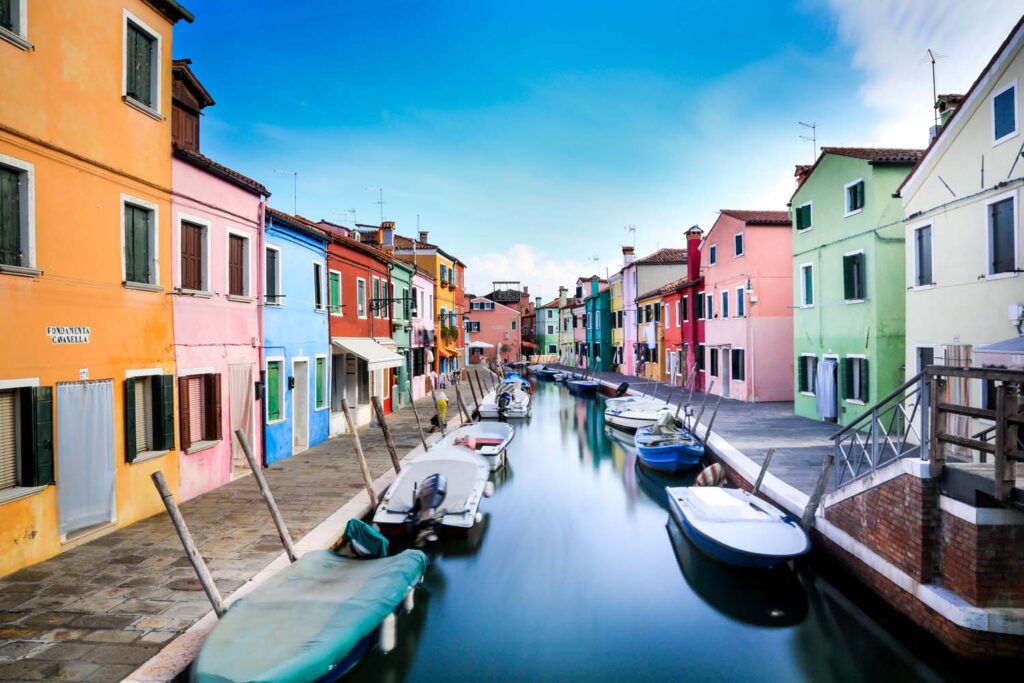
- How to Get There
- When to Go
- History of Burano
- Walking Tour | Start the Ferry Dock
- Remigio Barbaro Sculpture
- Strada di Corte Comare
- Colourful Houses of Burano
- Supermarket Stop
- Panificio Pasticceria Garbo
- Corte Comare
- Fondamenta di Cavanella
- Pescaria Vecia
- Via Giudecca #101
- Fondamenta della Pescheria
- Via Baldassarre Galuppi
- Da Primo
- Dalla Lidia Merletti d'Arte
- Pasticceria Costantini
- Piazza Baldassarre Galuppi
- Istrian Stone Well
- San Martino
- Lace Museum
- History of Lace in Burano
- Merletti dalla Olga
- Terranova's Marble Bridge
- House of Remigio Barbaro
- Fondamenta di Terranova
- Ponte della Vigna
- Laundry
- Casa Bepi
- Fondamenta S. Mauro Bridge
- La Buranella
How to Get There
Burano is located off the main island of Venice. To get there you can hop on the Vaporetto line #12. This ferry runs directly from the San Zaccaria dock near St. Mark’s square. The journey takes around 45 minutes and costs €6.50 per person. But if you bought a multi-day travel card this will be included so the trip won’t cost you a thing!
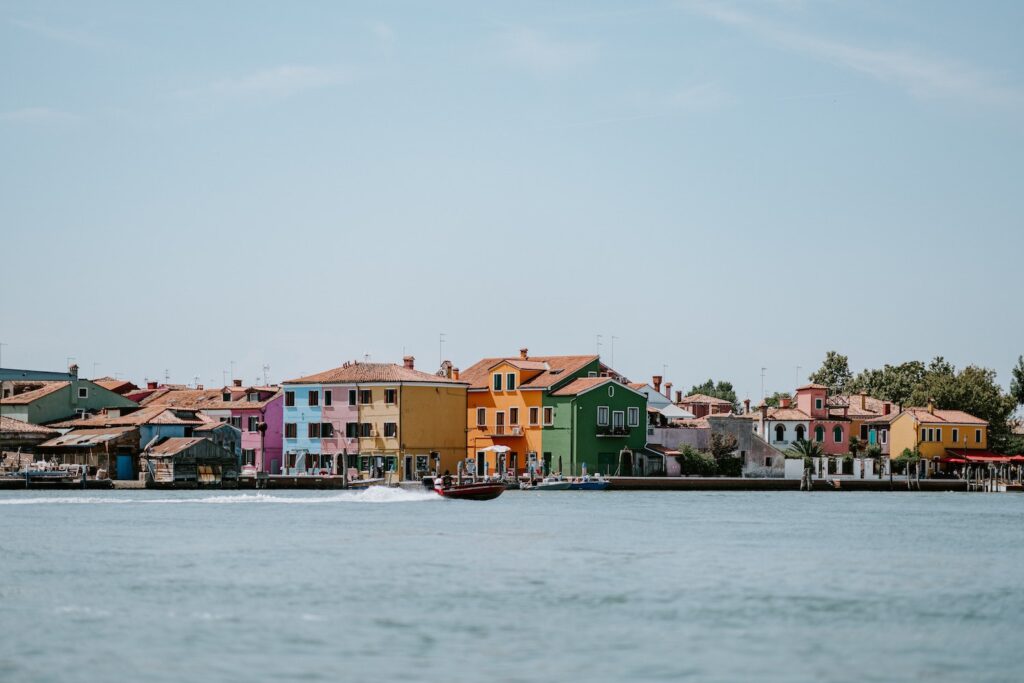
When to Go
This island gets mobbed by tourists! Before Instagram, this island was a peaceful escape from Venice, and often overlooked in favour of Murano‘s famous glass island. But these days it gets really busy. But let’s face it, we’re all going there for the same reason so you kinda have to take the tourists with a grain of salt. The best way to avoid the crowds is to go super early in the morning. The sunrise from the ferry over the water on your journey to Burano is gorgeous and a great reward for early risers.
History of Burano
Much like the citizens of Venice, the people who would begin to inhabit the island of Burano came here to escape the Barbarian invasions. The island was a refuge in the lagoon, protected from the attacks coming in from the Adriatic Sea. The name “Burano” was taken from the words “Porta Boreana”, which meant northern door of the city.
The island was inhabited mainly by poor fishermen and therefore there never were too many fantastical palazzos constructed here. Even when the lace trade was at the height of its popularity, lace workers were heavily underpaid so there continued not to be a huge amount of wealth coming into this city. But what you’re left with is an authentically preserved town that encapsulates the way everyday Italians would have lived hundreds of years ago.
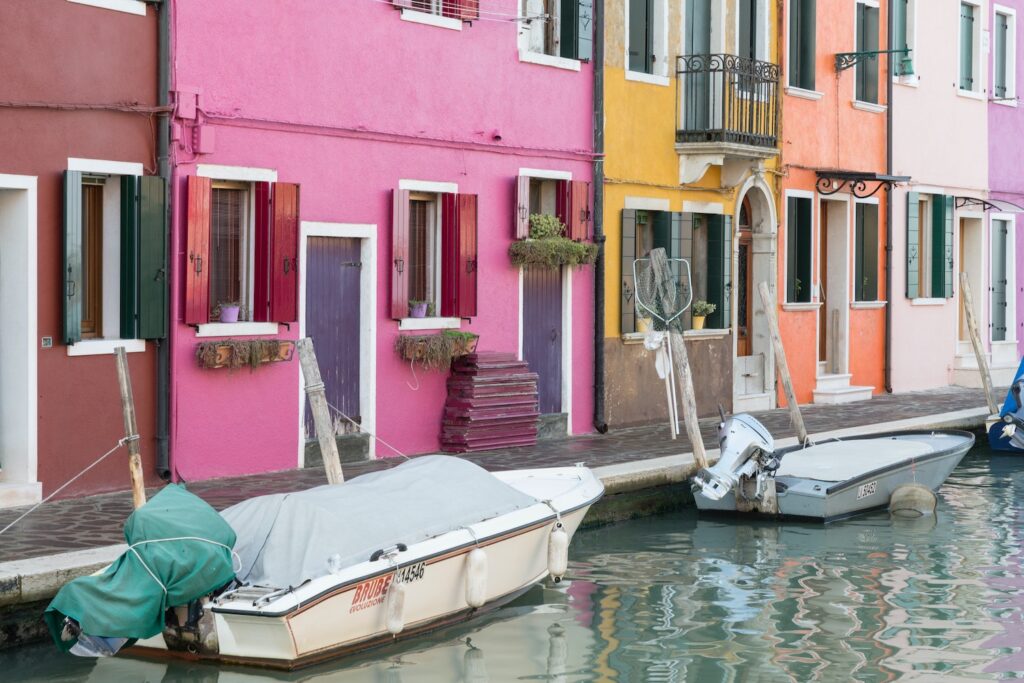
Walking Tour | Start the Ferry Dock
After disembarking the Vaporetto you are immediately struck by how different this island is to Venice. The green grass which greets you upon disembarking is one of the most significant differences as the grass is almost impossible to find in Venice. Large trees seem to swell and protect pedestrians sitting on the benches below. People are mulling about as their every day begins, fishermen loading nets into their boats along the shore and women out for their brisk morning walk.
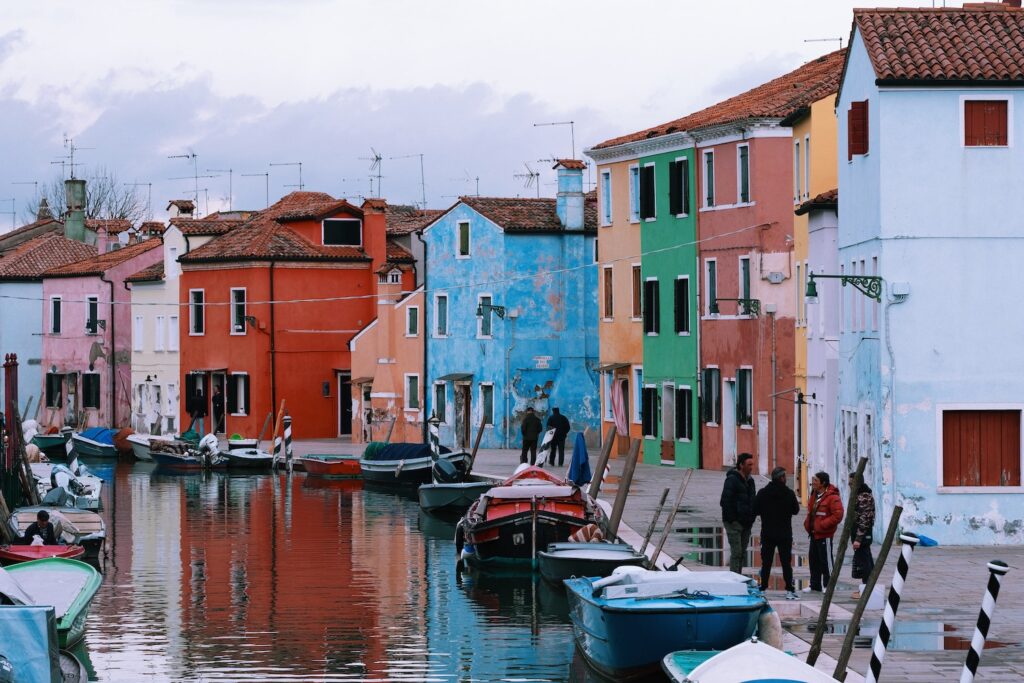
Remigio Barbaro Sculpture
In front of the ferry dock is a bronze sculpture of a naked woman with her arms behind her head, crying out as if in distress. Many fishermen who went out to sea would have lost their lives over the years and this woman represents their collective grief. The statue was made by Remigio Barbaro, a local Burano sculpture who is one of the most famous artists who lived on the island.
Strada di Corte Comare
Head westwards until you reach the Strada di Corte Comare. Turn up this street and as you take your first steps, you’ll be immediately amazed at the wonderfully colourful houses all around. I couldn’t stop saying “wow” as I passed one brightly houses to another and the city started to weave its magical spell around me.
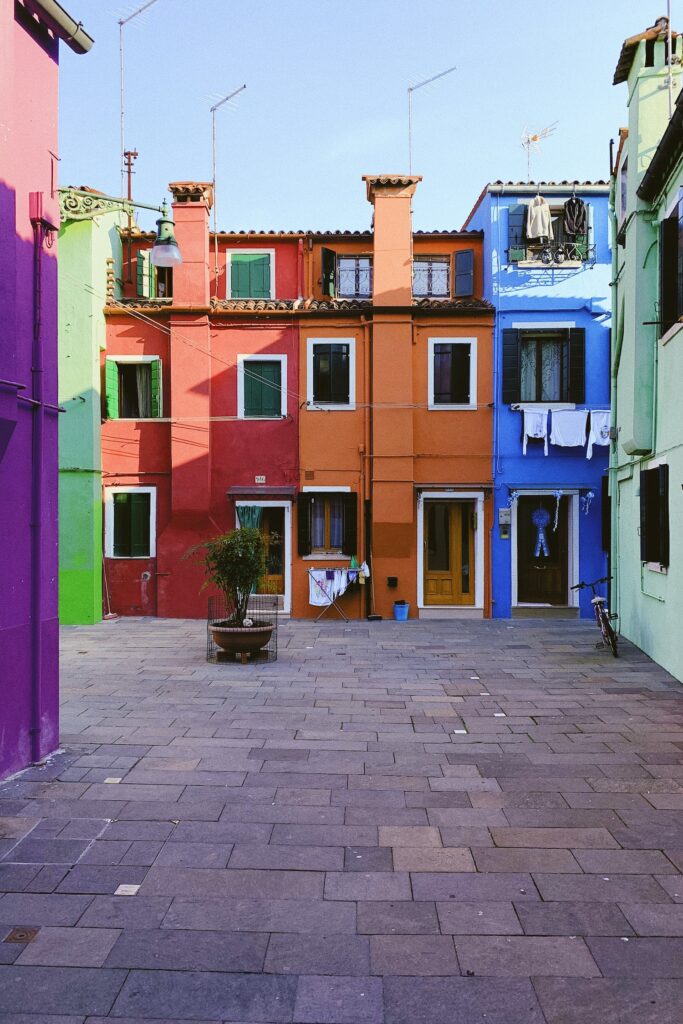
Colourful Houses of Burano
Walking along this street, imagine how fisherman, long before the advent of electricity or gas lightning would have found their way home during the misty winters that Burano was famous for. Sounds almost impossible right? White houses would simply disappear into the darkness. So, in order to see their homes from far away, fisherman began painting them these bright, sometimes only neon, colours.
The typical Burano home is pretty narrow and is only two or three floors tall. The ground level is where you’d find the kitchen and toilets. The upper floors would be where the bedrooms would be kept, to prevent the beds from getting wet during the rainy season.
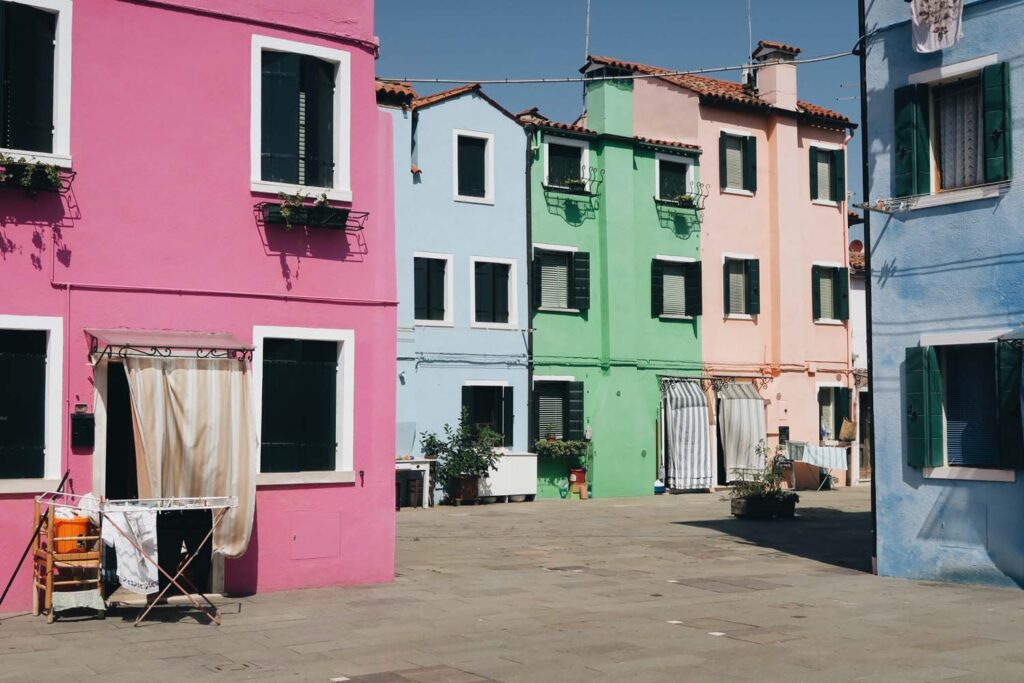
Colour Rules
But these houses aren’t just painted willy-nilly. Homeowners in Burano must write to the city council if they want to paint their house a different colour. The government will assess the area and let you know what colours are deemed ok for this area. I assume this is to prevent too many of the same coloured houses being painted in one area. Therefore making it more confusing for residences to find their home.
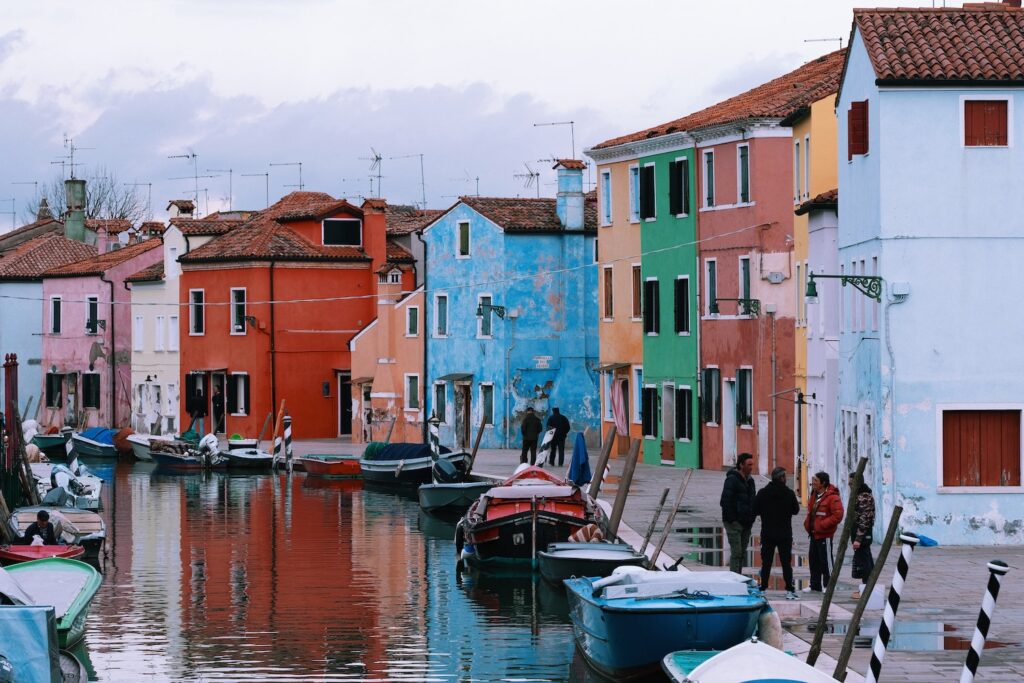
Supermarket Stop
When you approach the first opportunity to turn left, head down this side street until you reach the Supermarket on Via San Mauro. Stop in at this grocery store to pick up breakfast essentials. A picnic in one of Burano’s amazing parks is even better than sitting in a cafe. Grab some cheese, bread, and a beverage to enjoy once we reach the perfect little picnic spot!
Panificio Pasticceria Garbo
If you’d like a sweet treat for breakfast then be sure to stop in at Panificio Pasticceria Garbo. This bakery has been owned by three generations of bakers and sells all the amazing Italian treats you need to have a wonderful start to the morning.
Corte Comare
Walk south along the Via San Mauro until you reach the large square called the Corte Comare at the end of the street. This is a down to earth fisherman’s square, where for centuries people have been meeting to discuss the news of the day and catch up with friends.
In this square take notice of the various doorways facing the square. The doorways and window sills in Burano are some of the most interesting anywhere in the world. In Burano, most people leave their doors open to help with air circulation. To keep the flies out, a large sheet is hung over the doorway. I love all the different colour combinations you’ll see all over the island.
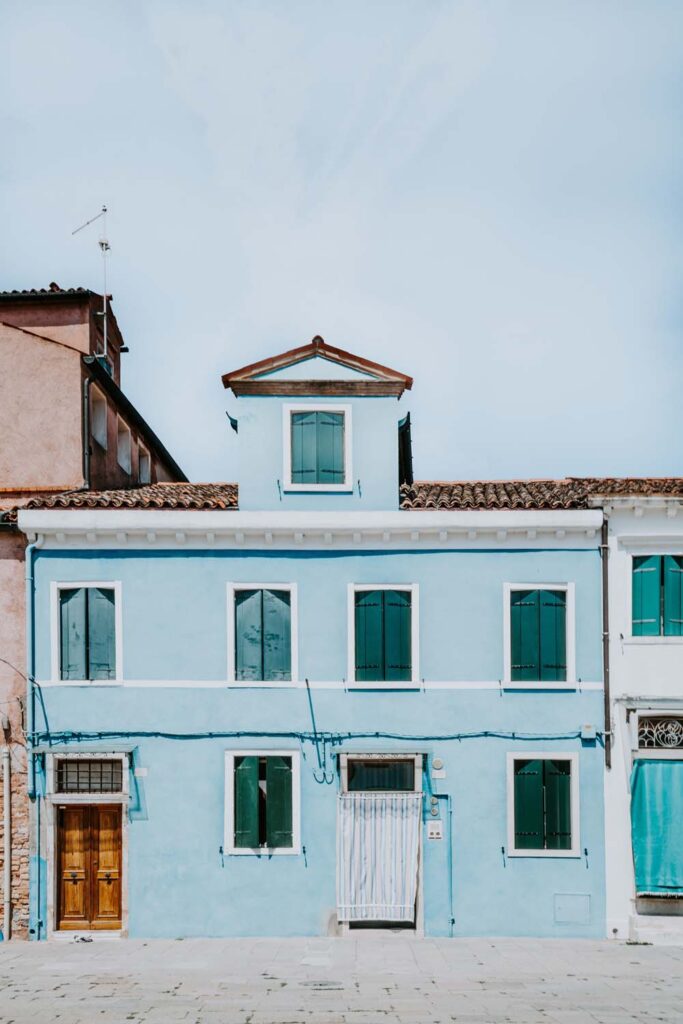
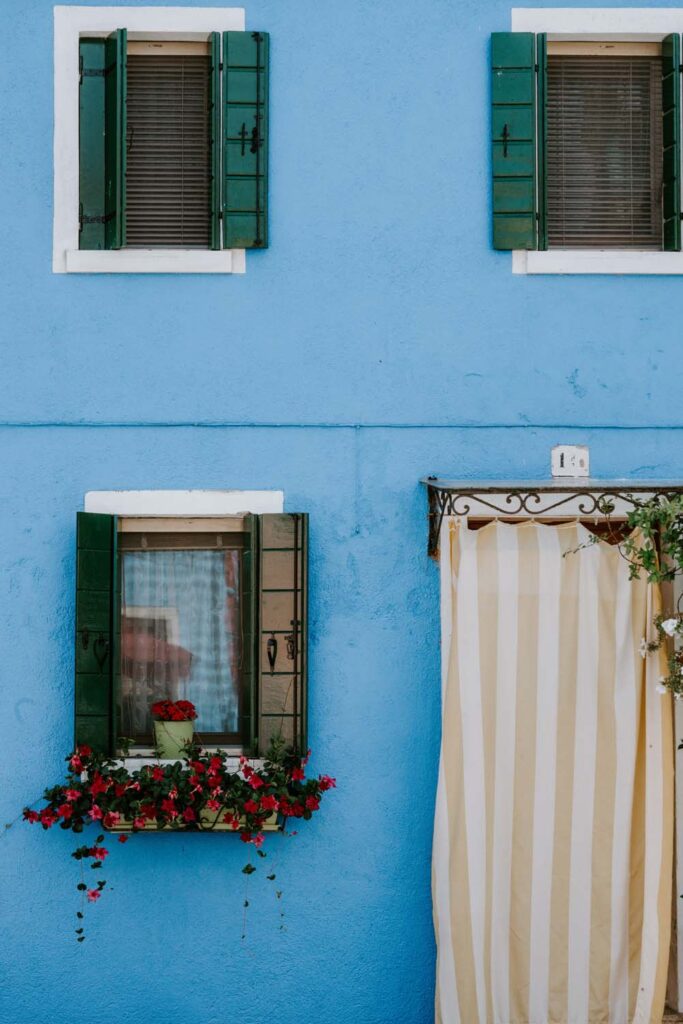
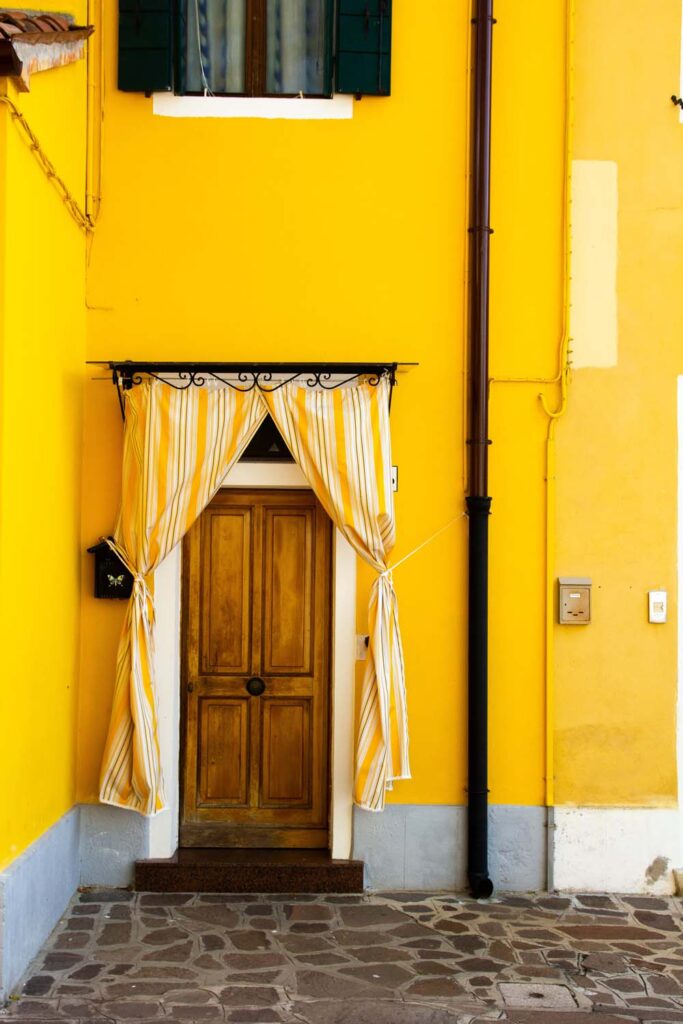
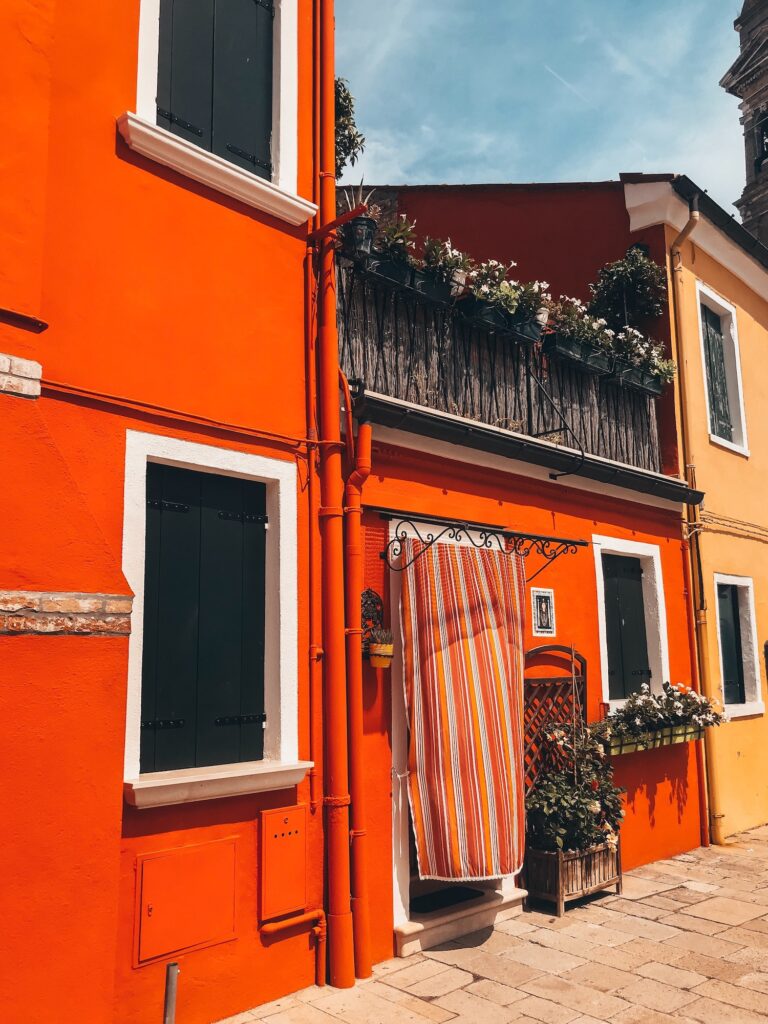
There is a small park nestled on the south-east corner of the Corte Comare. Here you can sit on the grass and enjoy a great view of the waterfront. Watch the boats chug up and down the lagoon, bringing in their catch of the day!
Fondamenta di Cavanella
After finishing your breakfast, walk down the Fondamenta di Cavanella towards the first bridge crossing on your right. These bridges are usually pretty packed with tourists but if you’ve taken my advice and come early in the morning you’ll have it more to yourself.
Pescaria Vecia
Cross over the bridge and walk along the parallel street to the one we just came from, Fondamenta di Cao Moleca. At the end of the street is an old brick structure with a simple red tile roof. This was once the old Pescaria Vecia, or Fish Market. Fishermen have lived and worked in Burano since the moment they came to these shores. There were no areas where the land was fertile enough for farming so fishing was an essential source of food.
Early fishermen used nets and harpoons to catch the fish and eventually also used “chebe” or cages. The cages would be used to catch bottom-feeding shellfish like crabs. Fishermen could trader fish for goods like wood and wine. It was the currency of the day in Burano. Today, catching fish is still one of the main occupations on Burano. There are over 450 different groups of fisherpeople who bring fresh seafood into the Rialto market and Venetian restaurants every day!
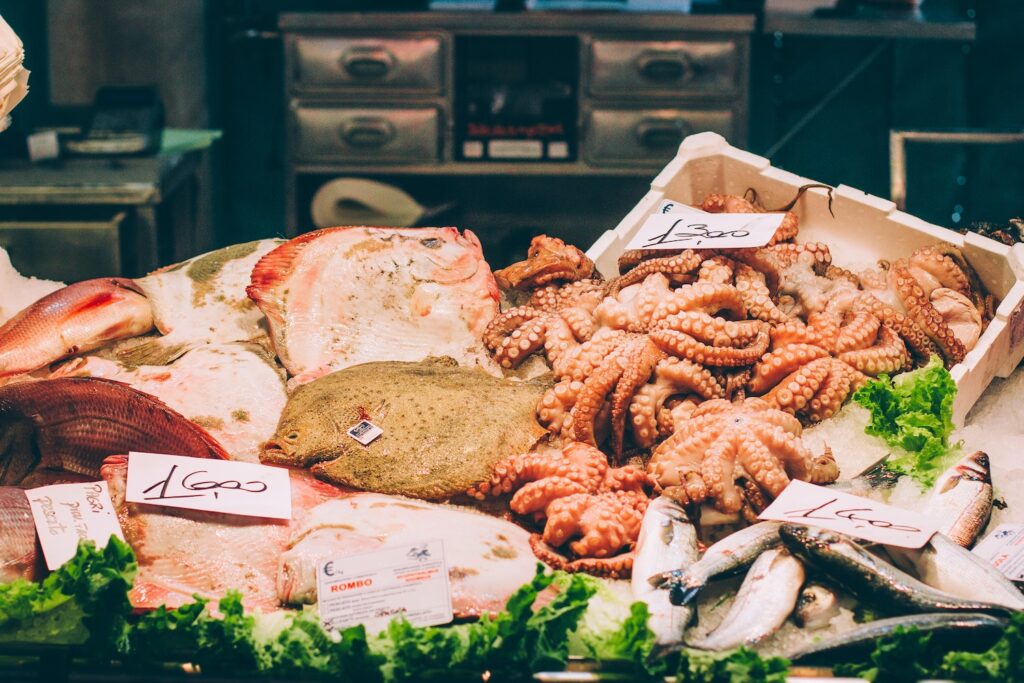
Via Giudecca #101
Backtrack back to the bridge and this time continues along Via Giudecca until you reach house #101. On the facade of the house is a bit of tile work which displays a beautiful quote about the colourful island. The words in Italian translates into; “Color is like music. It uses shorter ways to come to our senses to, wake our emotions.”
Fondamenta della Pescheria
Cross the bridge and walk west along the Fondamenta della Pescheria. This is one of the busiest areas but the houses along here are amazing. As you walk along, stop for a minute at the Campo della Pescheria. This is another one of the former outdoor fish markets. This was where the market was moved after a huge storm destroyed the previous one. Today the square is used on most days of the week as a pop-up market where local artisans come to sell their wares.
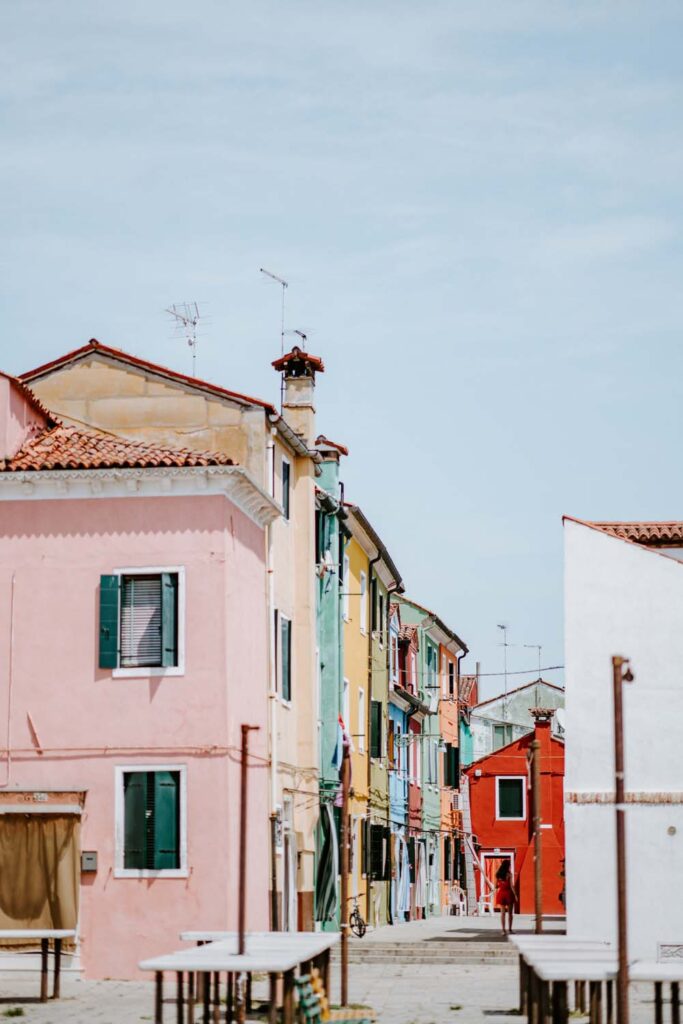
Leaning Tower of Burano
Standing in the square you have a gorgeous view of the famous leaning tower of Burano! The tower is apart of the church of San Martino and was built in the 17th century. The shifting ground beneath the island has resulted in the tower starting to lean over the years. Some maintenance work was carried out in 1703 but the issue has yet to be remedied.
Consider popping your head up a few sidestreets as you go. This is a great way to get away from the crowds and this narrow streets are always filled with such character.
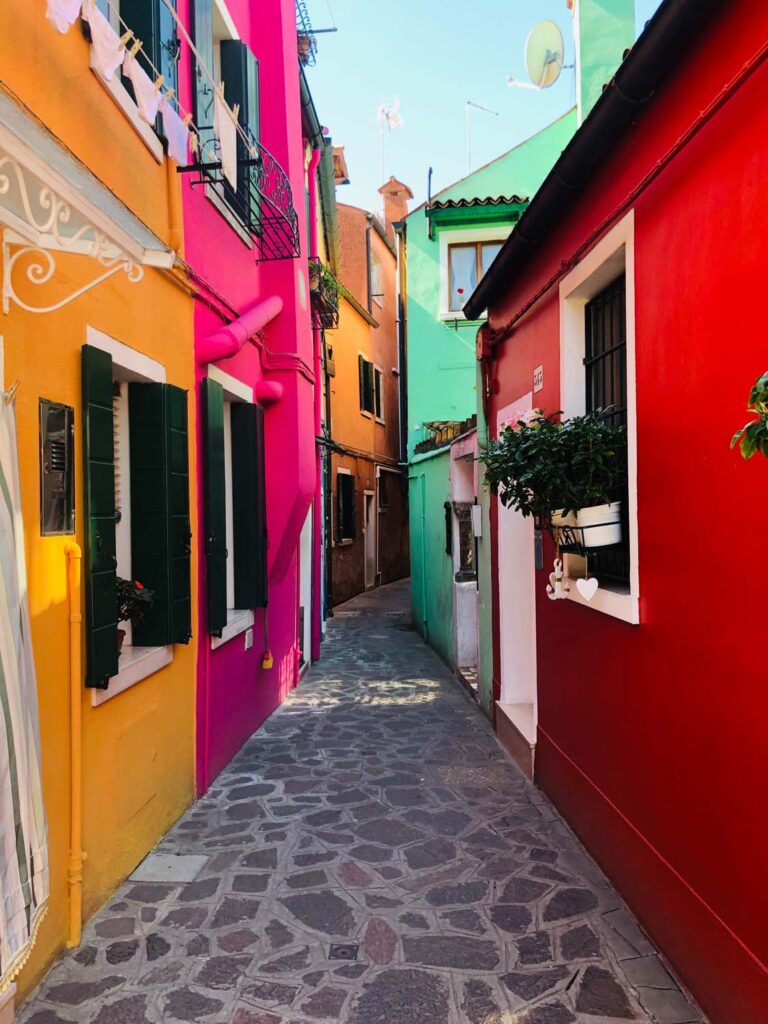
Via Baldassarre Galuppi
Walk down the Campiello dei Squeri, which turns into the Calle Mastelletti. This will lead you over to the Via Baldassarre Galuppi. This street is definitely the most touristy area in Burano. But the history of the street is important. Baldassare Galuppi, for whom the street is named, was one of Italy’s most important composers. He was dubbed “Il Buranello” to honour his home in Burano.
Galuppi loved music from the time he was born. His father was a mere barber but loved to play the violin in his spare time. Galuppi was surrounded by music as a child and inspired him to pursue this passion. Galuppi performed his first opera in Venice where he had been working as an organist. His first Opera performance was an utter failure, with Galuppi being booed off the organ by the audience. But he didn’t let one failure stop him and continued to practice and compose. Eventually, he started to be mentored by composer Antonio Lotti who would shape the rest of his career. Galuppi gained more and more success and became so famous he would preform his operas inside the great St Mark’s Basilica.
Da Primo
As its getting close to lunchtime, we better stop for something to eat. Eating a touch earlier or later in the day is a great way to avoid large crowds or waiting in line. Although many restaurants along this street are geared towards tourists, Da Primo is a worthy exception. Here you can eat like a local! One of the most famous dishes in Burano is the “risotto de gò” which is rice cooked in a rich fish broth. The fish broth is made from the “goby” fish local to the lagoons around Burano.
Dalla Lidia Merletti d’Arte
After all that food it’s time to walk those calories with a little bit of shopping. Lace is what first made this island famous. The practice is kept alive today, mainly by the tourism industry. One of the best shops to find traditionally made lace is Dalla Lidia Merletti d’Arte which is the oldest lace shop in Burano. The shop sells handmade lace in the form of linens, tablecloths, handkerchief, bedspread, nightgowns and most adorably, children’s baptism gowns.
The woman who runs the shop is the fifth generation of women to work here. She is wonderfully passionate about the craft and even if there to demonstrate how this lace is made. And while you can shop around for cheaper lace, you’re likely going to find it’s not handmade but machine made in China. It’s really worth splashing out for the real thing, and the prices at Dalla Lidia Merletti d’Arte are extremely reasonable!
Pasticceria Costantini
Walk up the street and turn to your right to grab a sweet treat for dessert. Pasticceria Costantini specializes in Burano’s local delight; the “Bussolà“. The bussolà of Burano is an “s” shaped cookie. These hard cookies were first made by the fishermen’s wives for times when the fishermen were out on long journeys. While the traditional cookie is made with lemon, rum and vanilla, you can find them with chocolate as well. They are a “must-eat” item to have while on the island!
Piazza Baldassarre Galuppi
Cookies in hand, walk over to the center of the Piazza Baldassarre Galuppi. This square is dedicated Baldassare Galuppi. In the middle of the Piazza, there is a monument in his honour, made by another Buranello, the sculptor Remigio Barbaro.
Istrian Stone Well
Also in the center of the square is a large, Istrian stone well. This well dates all the way back to 500 BC! The well still to this day supplies water to the nearby water fountain.
San Martino
Dominating the square is the large San Martino church. This 16th-century, Roman Catholic church remains vastly unchanged from the day it was first built. While the exterior isn’t much to marvel at, take a quick peek inside. The interior features a large marble sarcophagus. Inside it is said that the remains of all island’s patron saints are laid to rest.
The Myth of the Fisherman
The myths goes that in the year 1000, a few fishermen in Burano saw a large marble coffin floating out in the water. Dozens of men tried to move it but none could get it to budge. Then four children came forward. The fisherman laughed at them at first but were shocked when the children moved it without almost any effort. It is said that the purity of the children was what allowed them to move these holy relics.
Also, keep your eyes open while inside for a plaque on the wall. This plaque is dedicated to the eight people who lost their lives when a huge storm blew the old Fish Market we saw previously. The storm destroyed 240 houses and killed these eight fishermen. It was one of the deadliest events on the island.
Lace Museum
Opposite the church is the old Burano Lace School, whis is now the Lace Museum. This was where young girls were trained in the art of lace-making. The school was open from 1872 to 1970. After it closed down to teachings, it was transformed into a museum that provides visitors with a great introduction to the art of lace-making and its history on the island.
History of Lace in Burano
For more than 300 years, the island of Burano was known better as the “island of lace“. According to long-told story, a sailor was out at sea and wanted to bring home a present for the girl he was in love with. While fishing, he found a beautiful plant which he called the trina delle sirene or mermaid’s lace and brought it home to her. She was enamoured with the gift and wanted to immortalize it forever. So she set to recreating the plant in fine threads. And that’s how lacework was born… or at least that’s their story.
Lacemakers
The first lacemakers in Burano were women who worked in convents. The lace was exclusively made for the church to be used to decorate their vestments and altar cloths. These pieces of lacework were almost impossibly delicate, made with gossamer fine threads stitched together to form intricate patterns. Some of the women who made this lace would have spent their entire lives with their needle and thread, as women, especially in convents, were allowed to do little more than sewing. Spinsters and orphans would often be sent to a convent and find themselves making lace for the rest of their lives.
As lacework broke out of just being made for the church, lace guilds started to pop up all over Burano. The guilds were put in place to control the production. On this outlying island, away from the high society in Venice, merchants could get away with paying low wages to the women in these guilds. The 17th century was the heyday for lacework in Burano. It was seen as the very best lacework to be found anywhere in the world. They called it punto in aria or “points in the air” because of the almost impossibly fine formation of the threads, like that of a spider.
Lace as Status
Lacework was seen as a high-status symbol, and worn by many rich aristocrats. The finer the lacework, the more expensive the cost, and therefore the more you showed off. Much of this lacework was worn in portraits painted of noblemen, immortalizing the lace forever. Despite the high price of lace, the actual women who made these pieces never became wealthy themselves as most of the money went straight into the pockets of the merchants. The merchants lived in luxurious palaces in Venice, and the poor women of Burano who sometimes went blind from this difficult work continued living in poverty on the island.

Burano Lace Guilds
In the 18th century, the tradition of lacework began to lose popularity. Its association with noblemen was reviled by the Revolutionaries of the time. Merchants abandoned the guilds and women on Burano. But the tradition never really was abandoned by the lacemakers themselves. They continued to make lace on the island for themselves and passed down the skills to their children. Bobbin lace was invented by these new generations, a slightly faster way of making lace. Today on the streets of Burano you can still watch mothers and grandmothers making lace the same way it was done hundreds of years ago. Thanks to the tourist trade, this tradition lives on.
Merletti dalla Olga
After learning more about lacework, let’s visit another lace shop. Lace by Olga, or Merletti dalla Olga, specializes in turning lace into real works of art. One of my favourite things about this shop are the framed pieces of lace which cover the rich red walls. Even if you aren’t into wearing lace, you can find something that will look great on your walls. These beautiful framed pieces of lace, in the shapes of smaller items like butterflies or Saint icons cost between 12 and 18 euros which is really affordable and a great souvenir!
Terranova’s Marble Bridge
Crossing over the Terranova’s Marble Bridge, turn around. The view from the bridge or just behind the bridge has the most amazing panorama out towards the church of San Martino. Its framed on either side by the adorable multi-coloured houses iconic of this island.
House of Remigio Barbaro
Walk along the Calle Brolli which encircles the edge of the island. Walking along the water’s edge, you’ll come upon a brick house with a large forest in the yard (marked on the map). This is the house of artist Remigio Barbaro. Remigio Barbaro was born in Burano in 1911 and spent his event life here. He is greatly admired by the residents of the city for his beautiful sculptural works. He had wished for his house to be turned into a museum after his death but construction on the house has only continued and no museum has been opened yet. Hopefully, it will open one day but until then you can at least admire the beautiful location where the artists worked.
Fondamenta di Terranova
Cut down the side street after passing the Remigio Barbaro House and walk north along Fondamenta di Terranova. I love this stretch of sidewalk. This part of the city is very far away from the tourist hub and here you’ll almost always find locals on their way to get their shopping or just out for a walk. There is a real sense of peace here and the island suddenly feels less just like a tourist Disneyland and more like a real place.
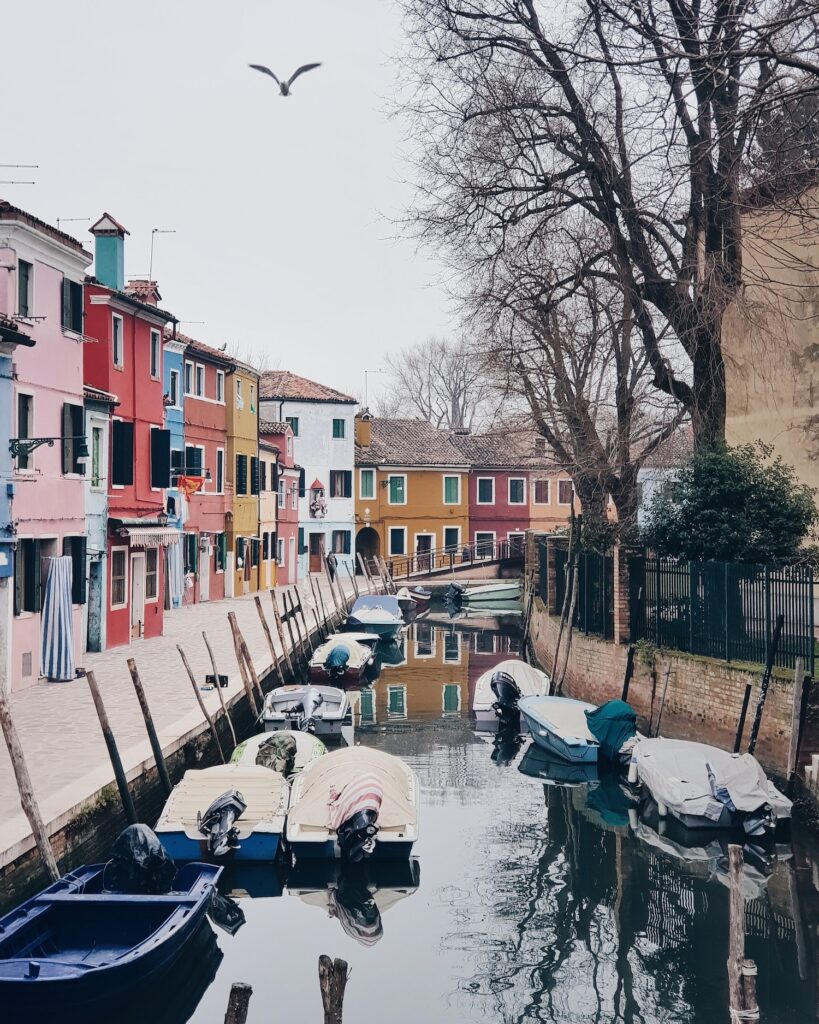
Ponte della Vigna
I think the Ponte della Vigna is my favourite of all the bridges on the island. Because it’s so quiet here and less packed with tourists the bridge has a truly romantic quality to it. Vigna means vineyards in Italian as there once was a small grove of grape trees nearby. The grapes were harvested by the convents on the island to produce their altar wine.
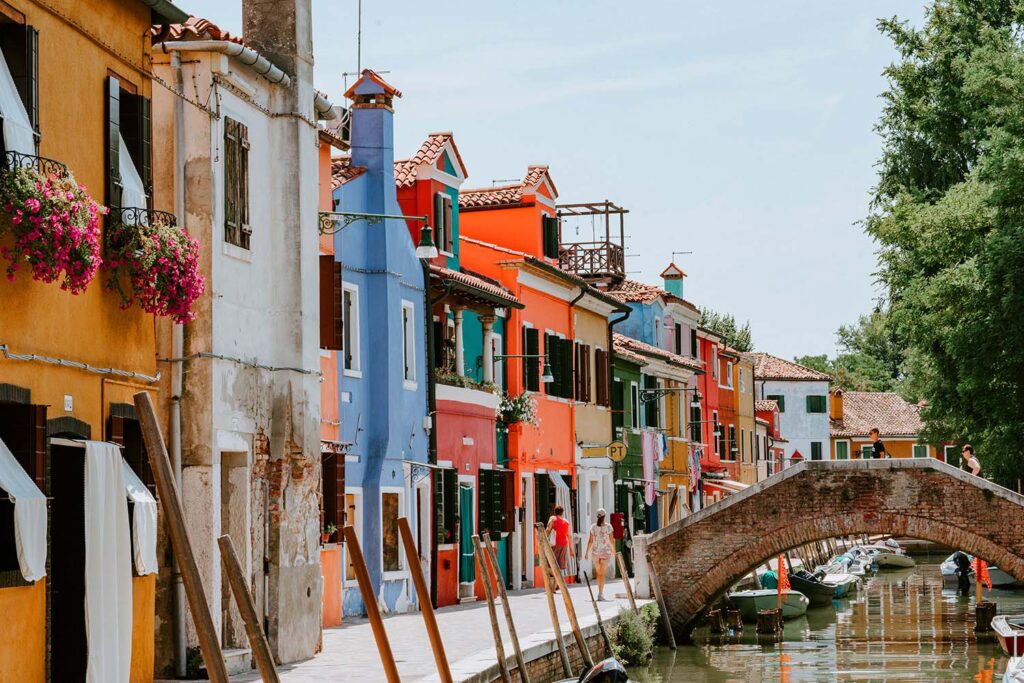
Laundry
Make your way from the bridge, west along with the Corte Romano Barbaro, then north up Corte del Pistro. These side streets are a photographers dream. They are almost devoid of tourists and they are also so picturesque. Laundry hangs outside the houses and across the streets, blowing in the wind. Just an idyllic scene in the middle of Burano.
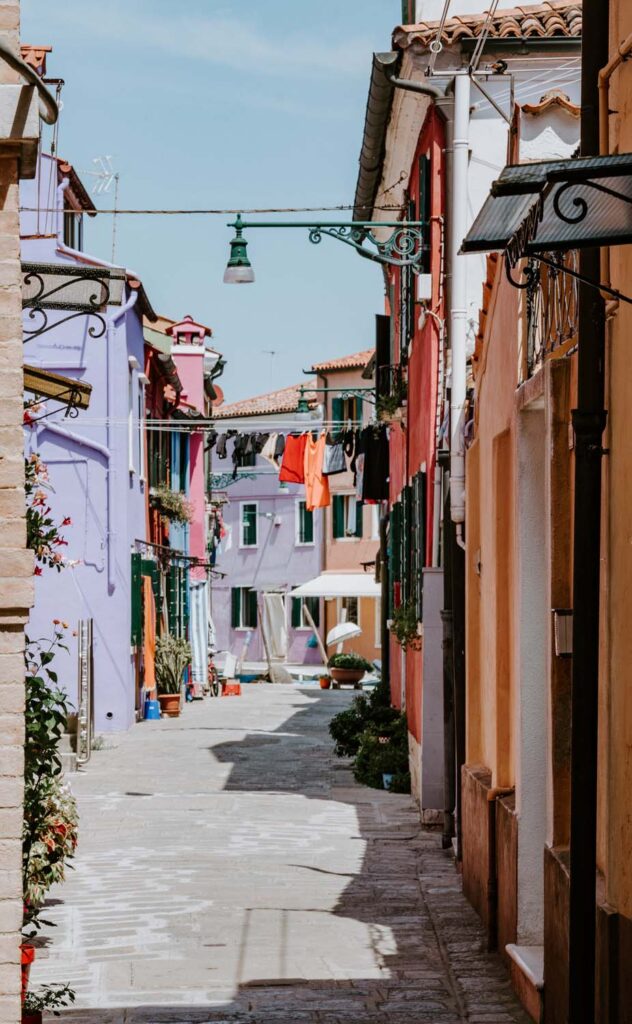
Casa Bepi
Continue until you reach the unmissable Casa de Bepi. The house is one of those famous facades you’ll see plastered on dozens of postcards in the city. While all the other houses in Burano are painted one solid colour, Bepi’s was painted with a variety of bright colours in geometric shapes. Bepi was a real man who lived here who would entertain local children with his brightly coloured drawing. He continued adding to his house every day until his death. Today the city ensures the facade remains just as colourful as the day it was painted to keep the memories of Bepi alive.
Fondamenta S. Mauro Bridge
Walking over the Fondamenta S. Mauro Bridge, look out east on the bridge towards the canal. The bend in the waterway here with the little boats lining the edge of the canal makes for a beautiful picture. This street is usually pretty empty making it look all the more scenic.
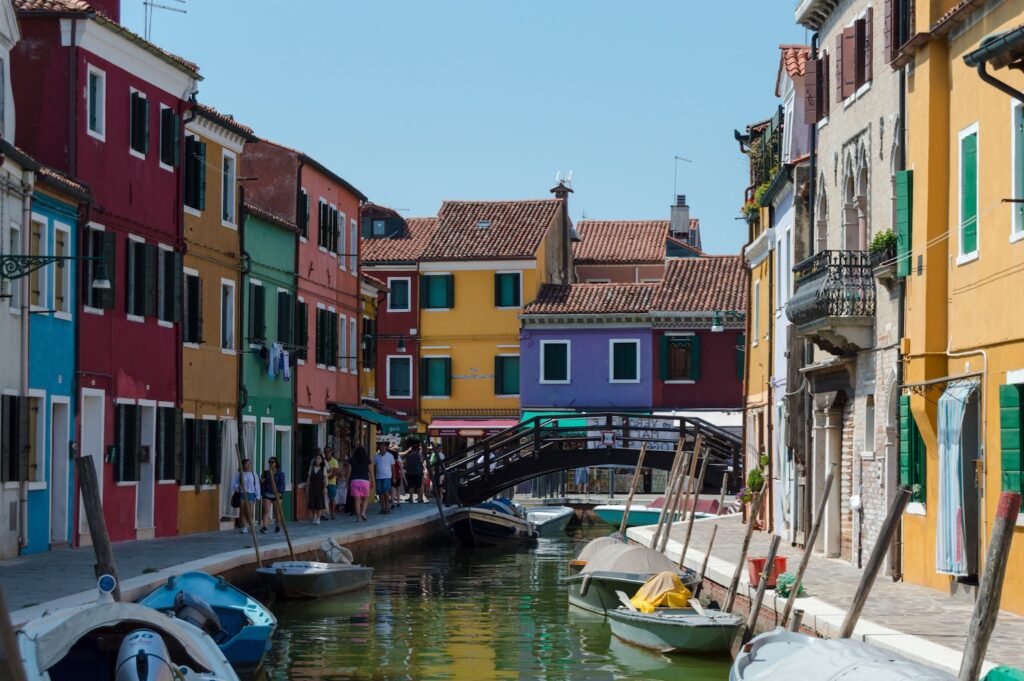
La Buranella
While there are dozens of cheesy souvenir shops in Burano, La Buranella is one of the only truly amazing shops which sells one-of-a-kind gifts. La Buranella specializes in colourful, hand made paintings of Burano landscapes. The man who paints them is also the owner of the shop and will happily chat with you about his amazing creations. There are items here for as little as 5 euros but made by someone right in the heart of Burano and not made in China. One of the best places to end out your day.
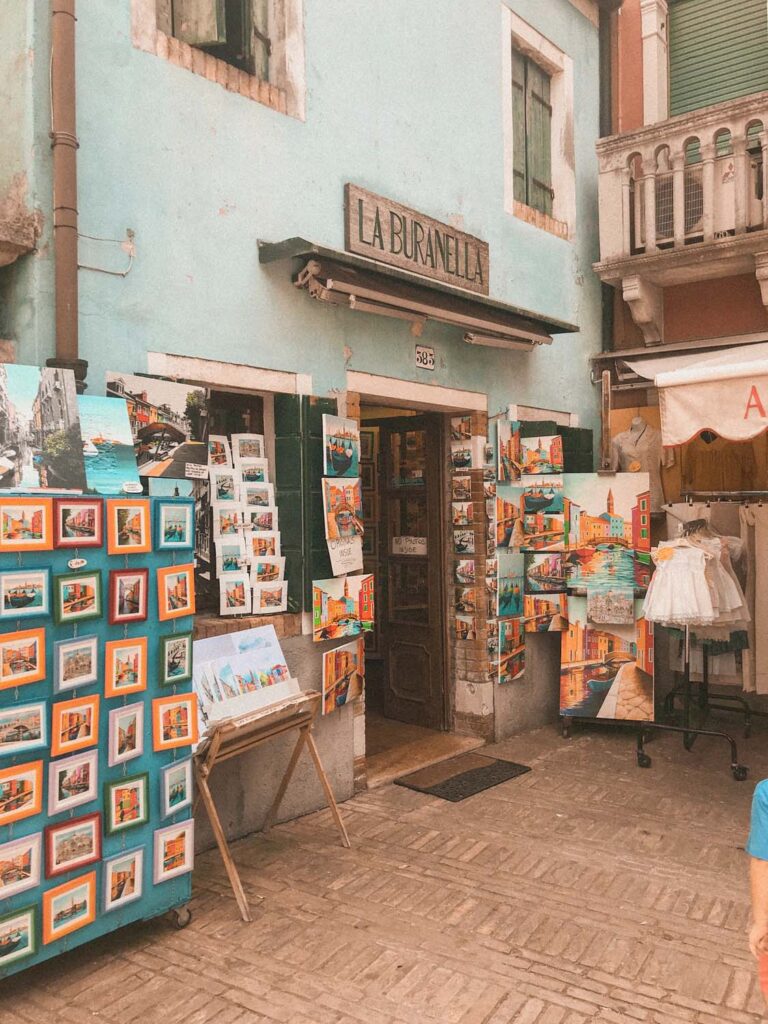
This brings us to the end of our tour. If you find the ferry dock busy with tourists, head over the island of Mazzorbo (just across the bridge). This is a great place to wander around and kill some times while taking in some beautiful green spaces.
Burano is such a vibrant and exciting place and well worth the mere 45-minute journey from Venice. If you bring your own food and skip the museum, the trip will cost you nothing more than the ferry ticket price. And if you’ve already purchased a multi-day travel card that’s covered too! I wish I could return here all the time when I’m feeling creatively drained as this colourful island just awakens all your senses and will revive anyone’s spirit. What are you most looking forward to seeing in Burano? Is it the lace or the houses? Let me know in the comments!
Happy Travels Adventurers!
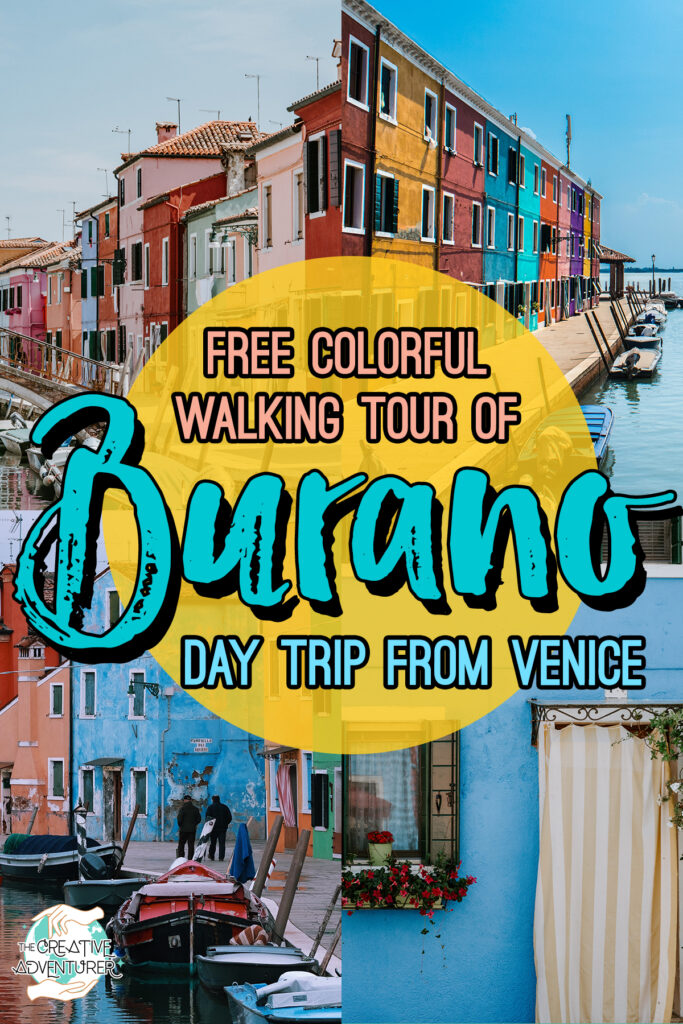
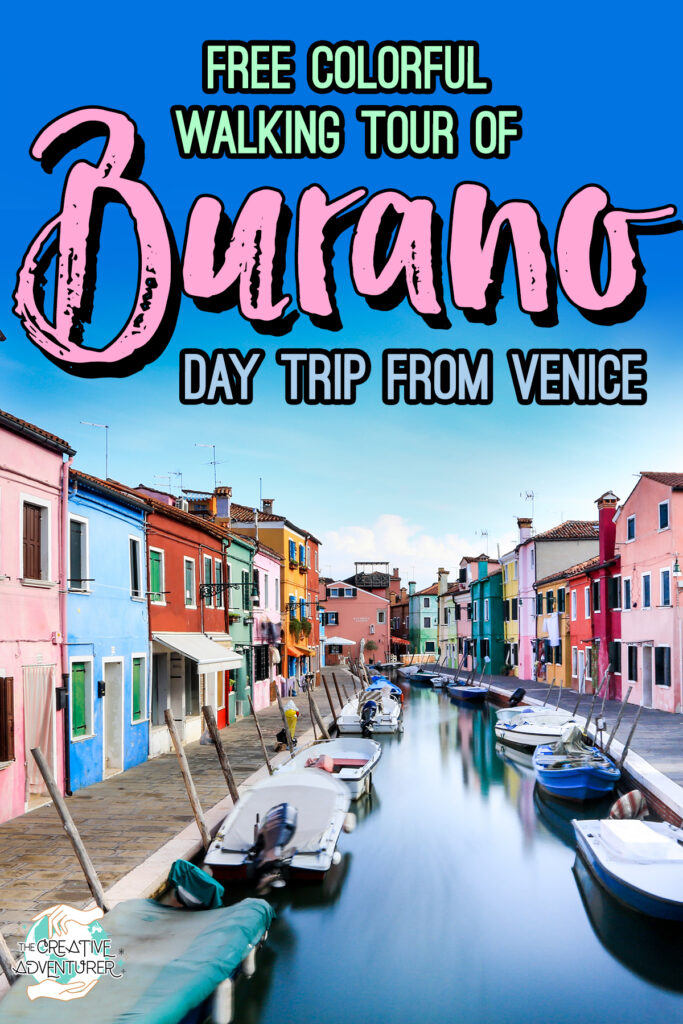
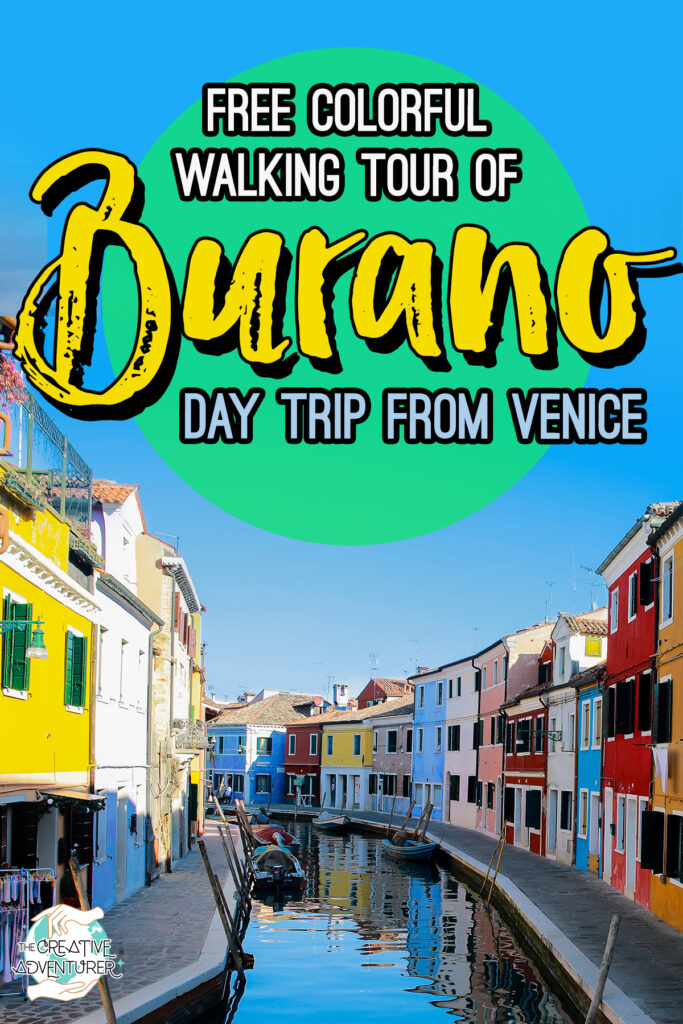
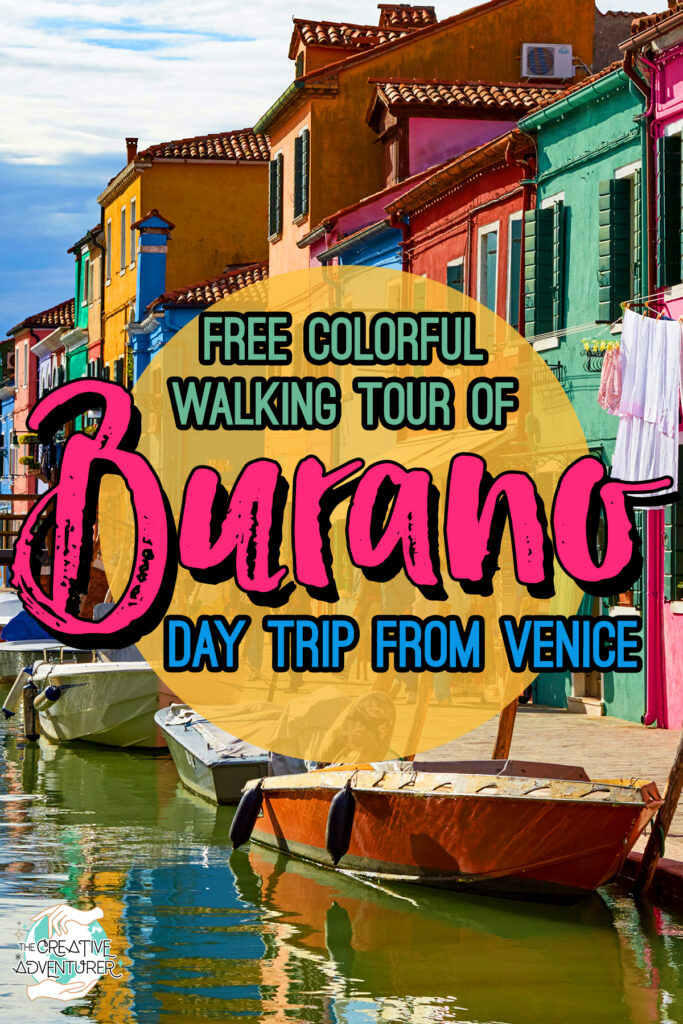

Leave a Comment
Pingback: Avoid These 10 Common Mistakes In Venice And Discover These Ultimate Activities Instead! - The Creative Adventurer on July 13, 2020

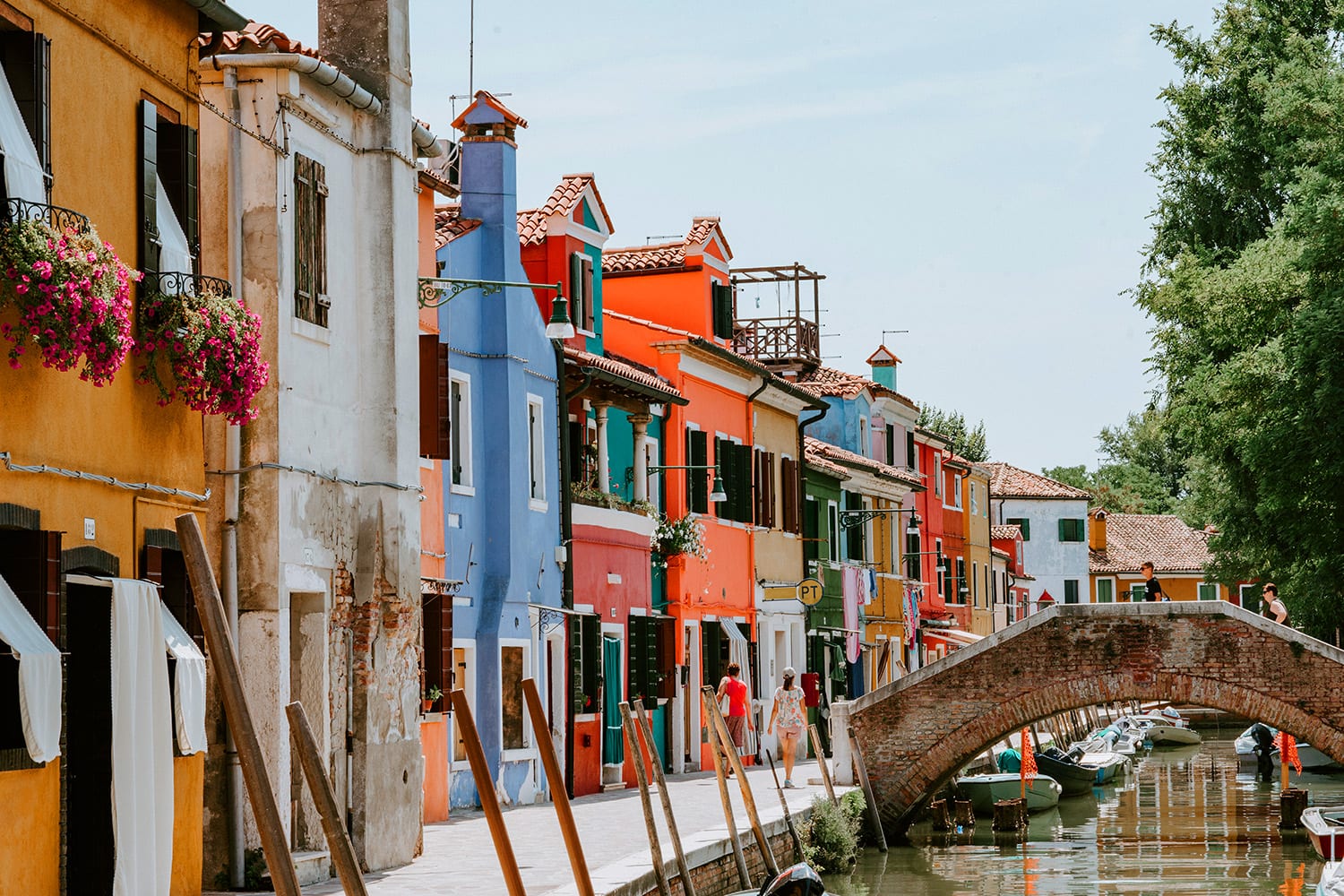
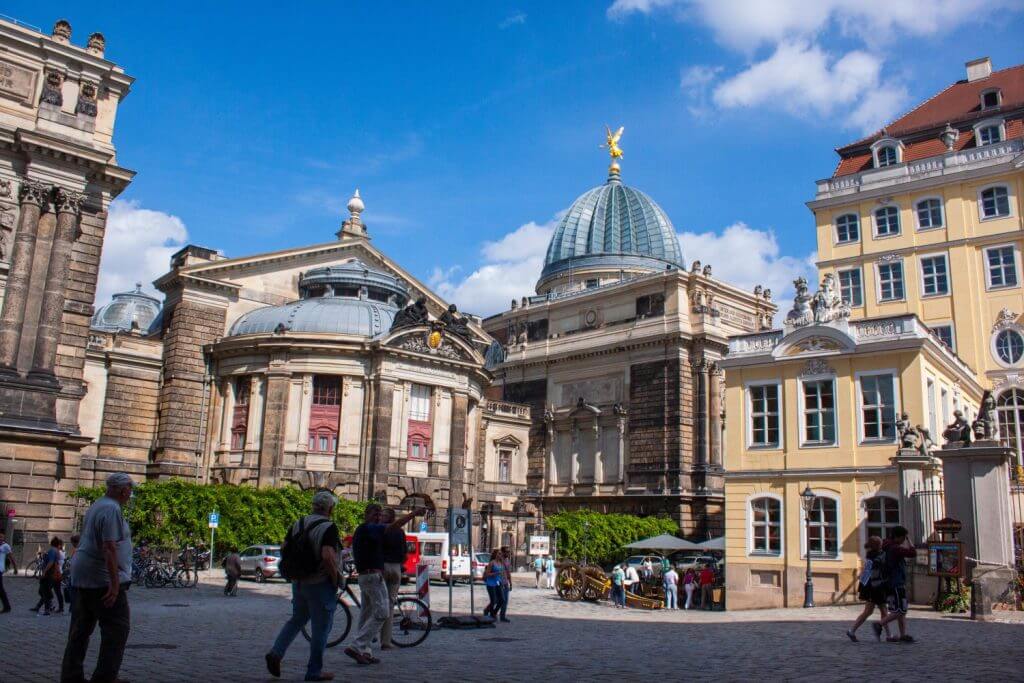
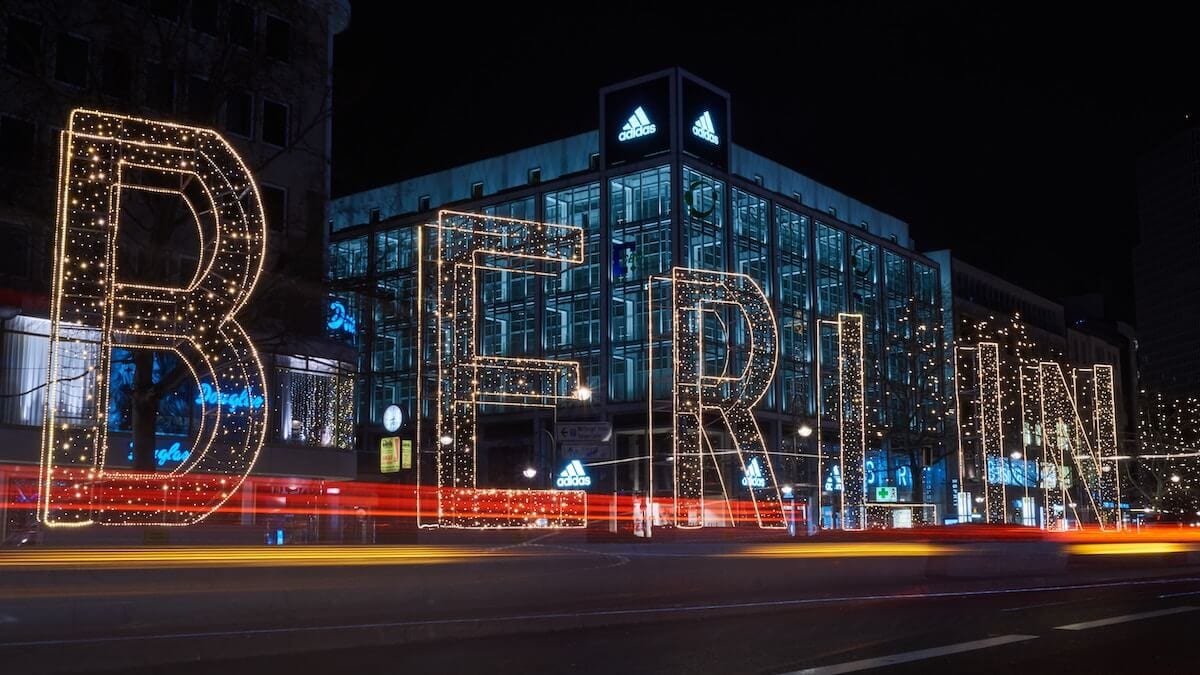
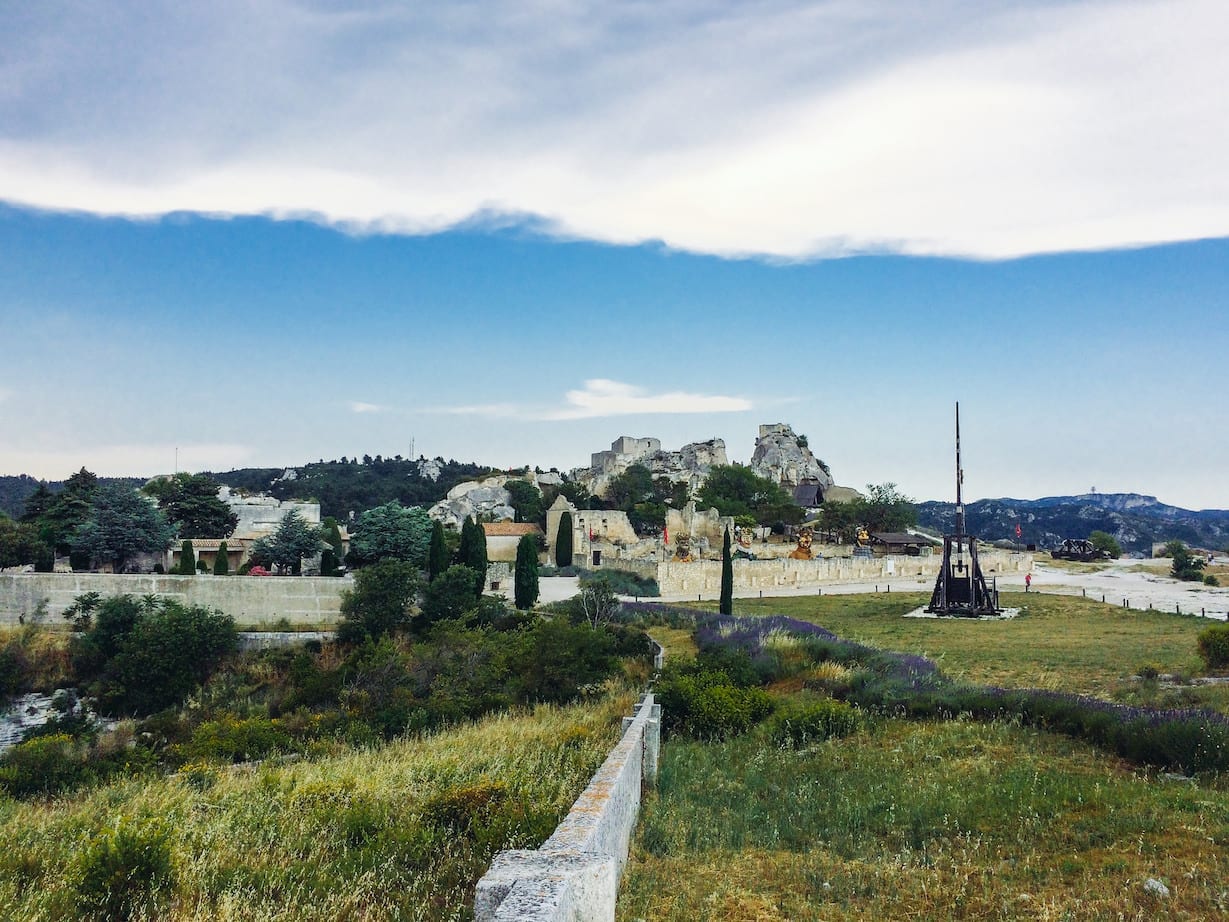
1 COMMENT